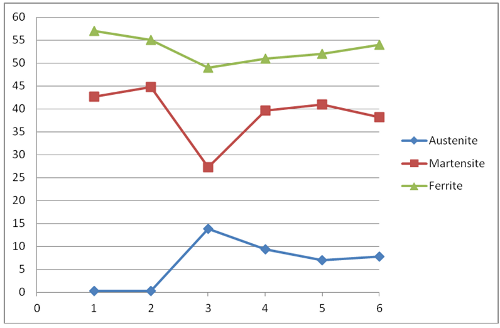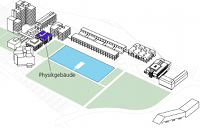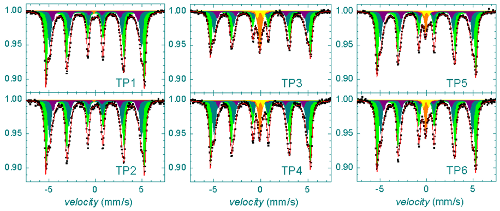Fig.1. Room temperature transmission Mössbauer spectrometry (TMS) spectra of steel samples after heat treatment
Position Indication:
Content

2011 - Sajjad Tollabimazraehno
Characterization of Martensite and Bainite in 0.2% Carbon content Steel by Mössbauer Spectroscopy
Research at Department of Nuclear Physics and Technology, Slovak University of Technology
Sajjad Tollabimazraehno
Contact: vorname.nachname(/\t)jku.at
In collaboration with K. Hingerl (JKU Linz), A. Pichler (Voestalpine stahl) and M. Miglierinii (Slovak University of Technology) this research stay led to the following results:
Introduction
Steels have notable role in industry and technology because of its wide applications and low cost. Improving the quality of steels because of these advantages are interesting for scientists. Our steel samples are classified as low carbon steel which contains 0.2% carbon. Steel properties can be changed by preparative techniques. In this case, samples have the same composition but they experience different heat treatments. All these influence the hardness, magnetism etc. and it also may affect the atomic arrangement which means different product phases such as martensite, bainite and pearlite [1-3].
Needle shape martensite microstructure has the bct lattice, while ferrite-bainite matrix and austenite have bcc and fcc lattice, respectively. Mössbauer spectroscopy can find out and characterize phases in steel samples with volume fractions as a remarkable technique [4-6].
Therefore, investigating different phases with volume fraction was the aim of the current study.
Methods
Mössbauer Spectroscopy
A Co/Rh source at the laboratory in Bratislava has been used as a Mössbauer source to radiate gamma photons. Mössbauer effect is a recoilless, resonant absorption and emission of ɣ rays in solid samples. If the nuclei in emitter and sample (absorber) are located in identical chemical environments, then resonant absorption will occur. Otherwise, different chemical environments will change the nuclear energy level less than a meV. There are different phase transformations in steel samples, carbon diffusion and carbon diffusionless transformations from parent austenite, which change the local environment of Fe-atoms. Austenite to martensite transformation is diffusionless transformation [7] and in other cases diffusional transformation was occurred. Different chemical environments and structure will cause isomer shifts, detactable with Mössbauer spectroscopy,the energical shift δ of the resonance energy is given by

And occurs due to different electron densities at the site of the nucleus. In addition, quadrupole splitting is a result of interaction between nuclear quadrupole moment and inhomogeneous electric field:

Hyperfine or magnetic splitting (Zeeman Effect) reflects interaction of nuclear with surrounding magnetic fields:

Results and Discussion
Mössbauer spectra contain one singlet and one doublet which reflect to austenite, two sextets which describe martensite [8,9] and one sextet which belongs to ferrite. Mössbauer spectra for all the samples with different components are shown in fig.1.
The measured transmission Mössbauer spectroscopy parameters a) quadrupole splitting Δ (doublet), b) magnetic hyperfine field Bhf (sextet), c) isomer shift δ and fraction of components A for the different phases are shown in table 1.
|
|
Spectral parameter |
Samples |
|||||
|
TP1 |
TP2 |
TP3 |
TP4 |
TP5 |
TP6 |
||
|
|
∆ (mm/s) |
- |
- |
0.61 |
0.51 |
0.51 |
0.57 |
|
δ (mm/s) |
-0.13 |
-0.14 |
-0.07 |
-0.07 |
-0.08 |
-0.08 |
|
|
|
30.79 |
30.79 |
30.84 |
30.73 |
30.89 |
30.74 |
|
|
Bhf (T) |
28.70 |
28.49 |
28.8 |
28.09 |
29.00 |
28.72 |
|
|
|
Bhf (T) |
33.09 |
33.09 |
33.10 |
33.09 |
33.12 |
33.07 |
Table 1. Parameters of TMS Mössbauer spectra: quadrupole splitting Δ, magnetic hyperfine field Bhf, isomer shift δ and fraction of components A for different phases
The relative areas of each component are summarized in fig.2 quantitatively. There is almost no austenite in samples 1 and 2 and austenite to bainite transformation was occurred in TP3 that’s why the minimum amount of martensite was observed on it.

Fig. 2. Relative area of spectral components for each sample
Conclusion
Different phases with volume fractions were measured by Mössbauer spectroscopy. The maximum amount of metastable austenite is observed in TP3 which experienced austenite to bainite transformation. There is almost no austenite in TP1,2 which quenched from austenite.
Bibliography
[1] S.A. Sajjadi, S.M. Zebarjad, J. Mater. Process. Technol. 189 (2007) 107
[2] F.L.G. Oliveira, M.S. Andrade, A.B. Cota, Mater. Charact. 58 (2007) 256
[3] J. Dash, H.M. Otte, Acta Metall. 11 (1963) 1169
[4] P. Grgac, M. Kusy, L. Caplovic, M. Miglierini, T. Kanuch, K. Vitazek, Mater. Sci. Eng. A 449–451 (2007) 1029–1032
[5] M.-X. Zhang, P.M. Kelly, L.K. Bekessy, J.D. Gates; Mater. Char. 45 (2000)
[6] I. Akgun, A. Gedikoglu, T.N. Durlu, J. Mater. Sci. 17 (1982) 3479
[7] Nishiyama, Z., 1978. Martensitic Transformation. Academic Press, New York
[8] P. Schaaf, Ch. Illgner, M. Niederdrenk, and K.P. Lieb: Hyperfine Interact. 95 (1995)199
[9] P. Schaaf, P. Bauer, and U. Gonser: Z. Metal l kde. 80 (1989) 77


 Audit hochschule und familie
Audit hochschule und familie


